by Emily Cross Leon | Mar 16, 2016 | Definitions
Headline inflation, measured by the Consumer Price Index for all Urban Consumers (CPI-U), was 1% for the year ending in February compared with 1.4% for the year ending in January. Prior to seasonal adjustments, consumer prices were reportedly up 0.1% in February and 0.2% in January. On a seasonally adjusted basis, the CPI-U fell 0.2% in February and was flat in January.
Today’s inflation report from the BLS was slightly stronger than expected. Gas prices plummeted 13% throughout the month to easily offset price pressure in other components of consumer spending such as rent and medical care. Stripping out the impact of declining energy prices, the index for all items less energy increased an annual 2.1% and climbed 0.3% in February with monthly seasonal adjustments. Core inflation (which eliminates both food and energy) was 0.3% for the month, marginally higher than the market’s forecast of 0.2%. Core prices appear to be gaining momentum.
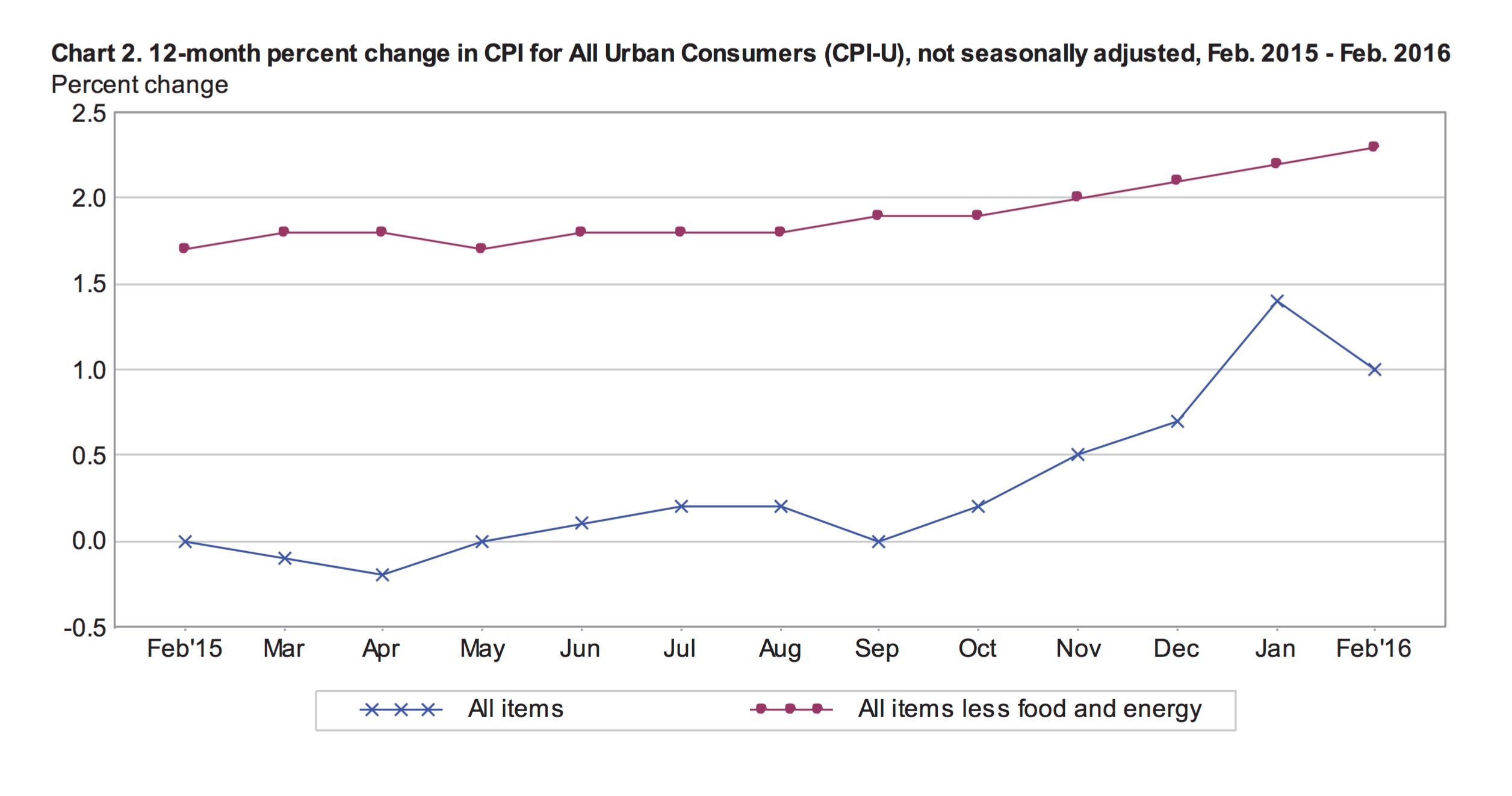
Seasonally Adjusted Prices in February
February’s 13% decline in the cost of gasoline led to a 6% decline in the energy index. The energy index, which accounts for about 6.7% of total consumer spending, declined 2.8% in January. The cost of energy services was up 0.1% in February following two monthly declines of 0.7%. The price of utility services (piped gas) was significantly higher (1%) for the month following 5 months of consecutive declines. The transportation index slid 2.5% in February. The prices of new and used cars and trucks were higher while the index for motor vehicle parts and equipment slid 0.1%.
Seasonally Adjusted Monthly % Change in CPI-U by Category (2016)
| January | February | March | April | May | June | July |
| All Items | 0 | -0.2 | 0.1 | 0.4 | 0.2 | 0.2 | 0.0 |
| Food | 0 | 0.2 | -0.2 | 0.2 | -0.2 | -0.1 | 0.0 |
| Energy | -2.8 | -6.0 | 0.9 | 3.4 | 1.2 | 1.3 | -1.6 |
| Gasoline | -4.8 | -12.5 | 2.2 | 8.1 | 2.3 | 3.3 | -4.7 |
| Fuel Oil (non seasonally adjusted) | -6.5 | -2.9 | 1.7 | 1.9 | 6.2 | 3.7 | -1.5 |
| Electricity | -0.7 | -0.2 | 0.4 | -0.3 | -0.2 | -0.5 | 0.5 |
| Utilities (piped gas service) | -0.6 | 1.0 | -0.7 | 0.6 | 1.7 | -0.4 | 3.1 |
| Energy Services | -0.7 | 0.1 | 0.2 | -0.1 | 0.2 | -0.5 | 1.0 |
| All Items Less Food and Energy | 0.3 | 0.3 | 0.1 | 0.2 | 0.2 | 0.2 | 0.1 |
| Services Less Energy Services | 0.3 | 0.3 | 0.2 | 0.3 | 0.4 | 0.3 | 0.2 |
| Shelter | 0.3 | 0.3 | 0.2 | 0.3 | 0.4 | 0.3 | 0.2 |
| Transportation Services | 0.4 | 0.2 | 0.2 | 0.7 | 0.3 | 0.3 | -0.2 |
| Medical Care Services | 0.5 | 0.5 | 0.1 | 0.3 | 0.5 | 0.2 | 0.5 |
Every other major component of the CPI-U was higher in February after seasonal adjustments. The largest positive change was a 1.6% monthly increase in the price of apparel, which was also up 0.6% in January following 4 months of declines. In February, prices were mixed within the apparel sector with major moves in the prices for jewelry and watches, up 3.2% and 8.9% respectively.
The cost of food was 0.2% higher in February including a 0.1% increase in the cost of food away from home and 0.2% increase in the price of food at home. Notable hikes at the grocery store include the price of fresh whole chicken, up 2.2% for the month and fresh fruit, up 2.3%. At the same time, the index for bacon and related products was down 3.1% in February. The overall cost of meat declined for the third consecutive month, down 0.2%.
Shelter costs, which account for about one third of the overall price index, were 0.3% higher in February. Hotel costs and moving costs are included in the shelter index and were up 1% and 3.1% respectively. The index for household furnishing and supplies slipped 0.2% in February compared with a decline of 0.1% in January.
The medical care index was up 0.5% in February, matching January’s growth rate. The index for medical care commodities rose 0.6% in February following an increase of 0.4% in January. Higher medical commodity prices were impacted by a 1.1% monthly spike in the price of medicinal drugs. The medical care services index increased by 0.5% in February, in line with January. Health insurance was reportedly 1.3% more expensive in February following a price increase of 1.1% in January.
12-Month Inflation
Overall prices grew by 1% over the 12-months ending in February, well below both the Fed’s target inflation rate of 2% and January’s 12-month inflation rate of 1.4%. While commodity prices fell 1.6% year over year in February, the overall cost of services was up 2.6%.
Food prices rose 0.9% despite an annual decline in the cost of food at home, down 0.3%. For the year ending in February, the price of meat fell 4.8% and milk prices were down 5%, while eggs were 6% more expensive. Apples and tomatoes posted sharp gains, up 7.9% and 10.8% respectively. The index for food away from home was up 2.6% year over year, led by higher costs for food at schools
Overall medical care costs were 3.4% higher for the year. Medical services were up 3.9%, including 5.1% higher prices for hospital service costs. The transportation index fell 3.4% year over year despite a 5.1% climb in the index for motor vehicle insurance. A 12.5% annual decline in the energy index includes a 32.1% decline in the cost of fuel oil and a 20.7% decline in the price of gas.
Across the Country
For the year ending in February, large west cost cities experienced higher inflation than the rest of the country. LA and San Francisco posted annual inflation rates of 2.4% and 3.0% respectively and prices in Seattle were up 2.2%. Prices were up 0.7% in cities in the northeast, and only 0.4% in the midwest.
In February, the northeast posted 0.2% higher prices, above the national average. Prices in the midwest were reportedly flat for the month and larger urban areas in this region saw monthly declines. In Chicago, prices fell 0.2% in February.
Outlook for the Fed
Stronger than expected underlying price pressures, as indicated by February’s core monthly inflation, will support the Federal Reserve’s intention to continue increasing interest rates. While they are not likely to move rates today, the likelihood of a second rate hike in the first half of the year is growing. A strong US dollar and cheap energy has quelled inflation but these factors may be temporary. Momentum in the prices of shelter and medical care point to underlying economic strength.
by Emily Cross Leon | Feb 22, 2016 | Definitions
According to the Bureau of Labor Statistics, consumer price levels, measured by the Consumer Price Index for All Urban Consumers (CPI-U), increased by 1.4% for the year ending in January compared to 0.7% for the year ending in December. After seasonal adjustments, the CPI-U was flat in January, following a decline of 0.1% in December. Falling energy prices were largely offset by higher shelter costs for the month.  Core inflation, measured by the index for all items less food and energy, climbed 0.3% in January and 2.2% for the year ending in January. This is marginally higher than the consensus expectations of 0.2% for the month and 2.1% for the year. January’s expectations were in line with December’s inflation numbers. The surprise acceleration in core price levels may reflect some underlying economic strength.
Core inflation, measured by the index for all items less food and energy, climbed 0.3% in January and 2.2% for the year ending in January. This is marginally higher than the consensus expectations of 0.2% for the month and 2.1% for the year. January’s expectations were in line with December’s inflation numbers. The surprise acceleration in core price levels may reflect some underlying economic strength.
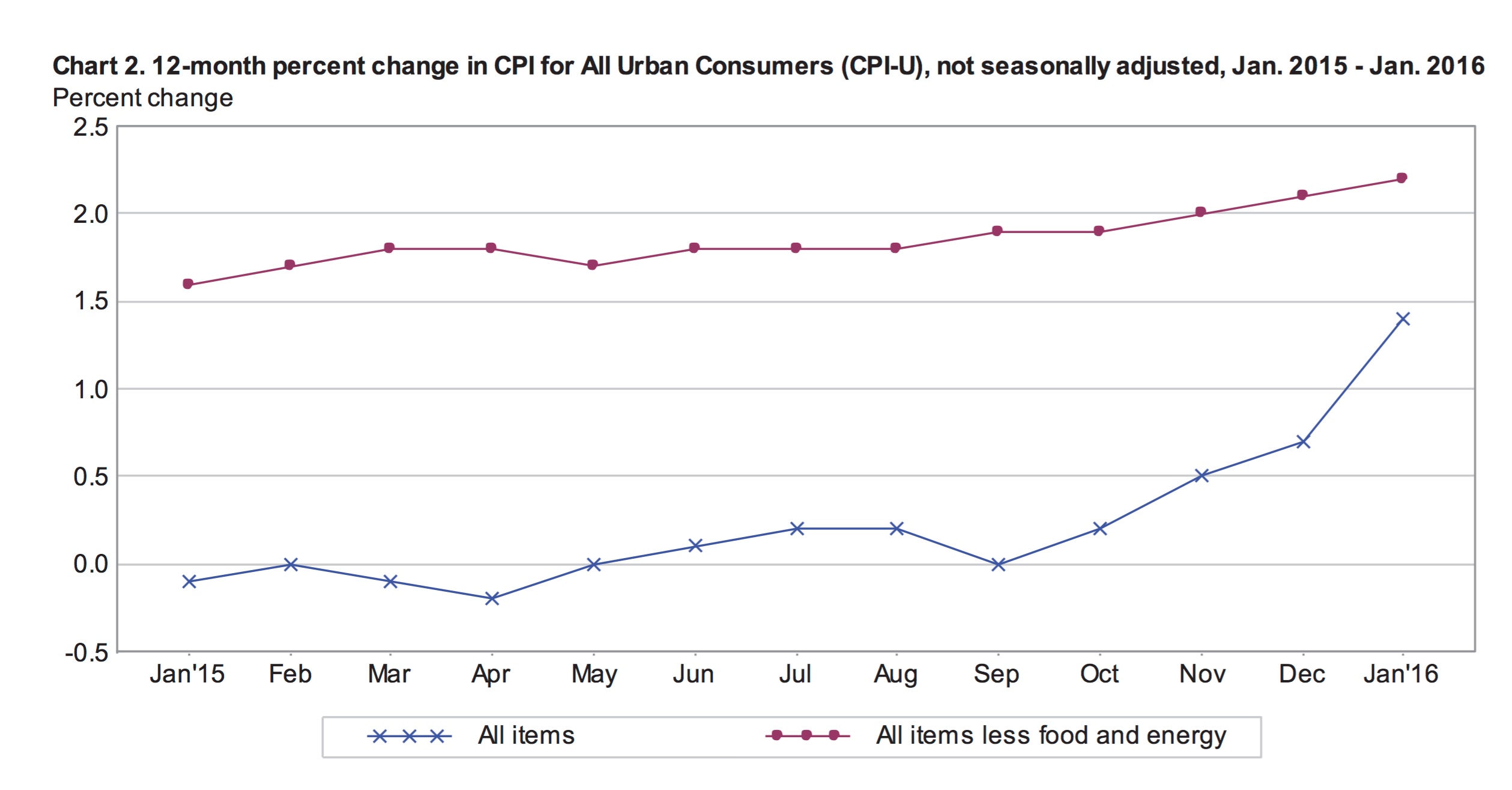
Annual Inflation
For the year ending in January, inflation was boosted by higher prices for shelter, medical services and transportation services. At the same time, sliding energy prices kept overall inflation levels relatively tame. The energy index was down 6.5% for the year ending in January and every component of the index declined. Year over year, fuel oil prices fell 28.7% and the gasoline index dropped 7.3%. The index for all items less energy climbed 2% for the year ending in January.
The food index inched up 0.8% for the year masking volatility within the index. The price of food at home slid 0.5% while food away from home was 2.7% more expensive. The price for food at employee sites and schools spiked 5.2% year over year. At the grocery store, meat prices fell 4.9%; milk was 7.2% cheaper; and the price of eggs increased by 6.8%. Fresh fruits and vegetables were 3.3% more expensive compared to a year earlier.
The cost of shelter, which accounts for approximately one third of the CPI-U, climbed 3.2% for the year ending in January and was the largest driver of overall inflation. The index for all items less shelter only grew by 0.5% year over year. Rental prices for primary residences were 3.7% higher in January compared with a year earlier. Over the same period, the index for health insurance jumped 4.8% and motor vehicle insurance climbed 5.4%.
Seasonally Adjusted Monthly Inflation
Every component of the energy index fell in January for the second month in row. Overall the energy index slipped 2.8% in January, including a 4.8% decline in the price of gas. These rates are identical to the changes in the energy and gas indexes in December. Energy and gas prices recorded marginal increases in October and November but appear to have resumed their downward path.
The food index was flat in January with all but one of the six major grocery store groups showing lower prices compared to the previous month. Fruits and vegetables cost 1.3% more in January versus December as tomato prices skyrocketed by 15.3%. The price of eggs tumbled 8.4% in January. Meat prices, particularly prices for beef and pork, also declined significantly over the month.
Shelter costs were 0.3% higher in January and helped balance falling energy prices. Other significant monthly growth was recorded for the medical care index, which climbed 0.5%. Medical insurance prices were up 1.1%. Apparel prices reversed their downward trend and rose 0.6% in January. The index for new vehicles increase by 0.3% while the index for used vehicles gained only 0.1%.
Outlook
The unexpected strength in January’s core inflation increases the likelihood that the Federal Reserve will raise interest rates sooner rather than later. Slow global growth and particularly slow growth in China, cheap oil and low domestic inflation have created skepticism about rate hikes this year. However, January’s annual core inflation rate of 2.2% is the highest recorded since June 2012 and is above the Federal Reserve’s target inflation rate of 2%.
Core inflation is considered to be a better gauge of underlying economic growth because the volatile, short-term price fluctuations within the energy and food components are eliminated. However, there is debate within the Federal Reserve regarding the true path of inflation and economic growth in the United States. A strong dollar drives down the price of imports, depressing inflation and higher rates will further lift the U.S. dollar. This would burden emerging economies and dampen global growth, which will impact the U.S. economy.
The Fed meets on March 15th and 16h to discuss monetary policy. It is unlikely that they will raise rates at that meeting. The futures markets are predicting that the chance of a rate hike this year is less than 40%.
by Emily Cross Leon | Jan 20, 2016 | Definitions
The Bureau of Labor Statistics released December’s inflation report this morning, rounding out the year with an unexpected monthly decline in price levels. Most analysts had forecast the headline consumer price index (CPI-U) would remain flat in December, instead it fell a seasonally adjusted 0.1%.
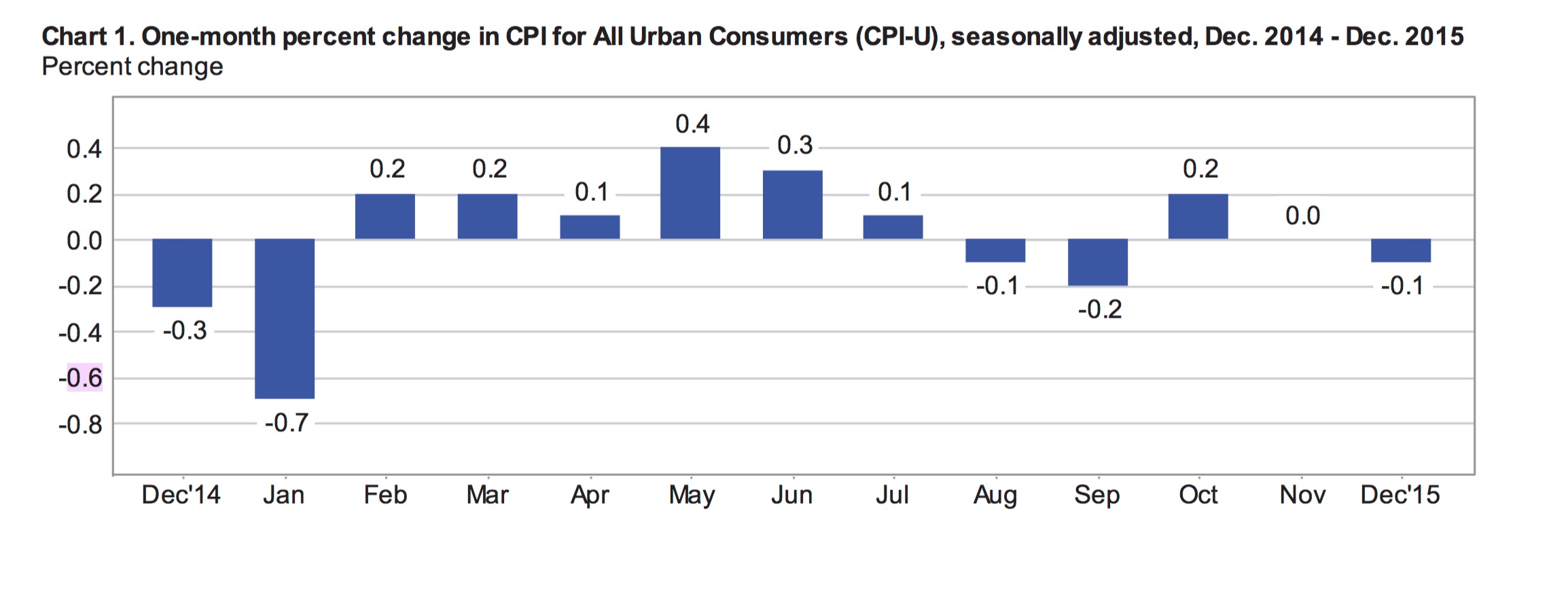 Once again, falling energy prices weighed heavily on overall price levels; the seasonally adjusted energy index fell 2.4% in December. Food prices were also down 0.2% for the month. Core inflation, which excludes volatile food and energy prices, climbed a modest 0.1% in December, following three consecutive months of 0.2% growth. Most analysts had expected another increase of 0.2% in the core reading. Core inflation is considered a good indication of underlying price trends and appears to continue to creep higher. Prices for housing, a significant component of consumer spending (approximately 43%), were up 0.1% in December. Housing was the largest positive driver of inflation for the month.
Once again, falling energy prices weighed heavily on overall price levels; the seasonally adjusted energy index fell 2.4% in December. Food prices were also down 0.2% for the month. Core inflation, which excludes volatile food and energy prices, climbed a modest 0.1% in December, following three consecutive months of 0.2% growth. Most analysts had expected another increase of 0.2% in the core reading. Core inflation is considered a good indication of underlying price trends and appears to continue to creep higher. Prices for housing, a significant component of consumer spending (approximately 43%), were up 0.1% in December. Housing was the largest positive driver of inflation for the month.
Rounding out the Year
The CPI-U climbed 0.7% in 2015, following an increase of 0.8% in 2014 and 0.5% for the 12 months ending in November. This is the highest annual number recorded for the year. Prior to 2014, the US economy only recorded inflation below 1% once in over 50 years; headline inflation in 2008 was 0.1%. The federal reserve targets an annual inflation rate of 2% so they are currently well below their target. According to the BLS, the CPI-U has increased at an average annual rate of 1.9% over the last 10 years.
Core prices climbed a healthy 2.1% in 2015 following an increase of 1.6% in 2014. Food prices were up slightly for the year but declining energy costs most impacted overall price levels. This created a large discrepancy between core and overall inflation numbers. The energy index, which accounts for just over 7% of the total CPI-U, fell 12.6% in 2015 and 10.6% in 2014.

The cost of shelter, which is about a third of the overall price index, accelerated throughout the year climbing 3.2% and significantly contributing to higher overall prices. The shelter index includes rental costs. The cost of rent for primary residence increased 3.7% in 2015 and the index measuring owners equivalent of rent climbed 3.1%. In 2015, every component of the shelter index was higher, including a spike in moving, storage and freight costs of 12.9%.
The index for food was up 0.8% for the year ending in December. Within the food industry, prices were volatile and mixed. The price for cakes, cupcakes and cookies rose 2.3% and the price of eggs was 14.8% higher. At the same time, the price of ham fell 10.5% and milk costs were down 7.9% for the year.
Seasonally Adjusted Prices in December
For the month, energy was, again, the main driver of changes in price levels. On a seasonally adjusted basis, the cost of fuel oil fell 7.8% in December while gas prices were down 3.9%. The index for transportation slid a seasonally adjusted 0.8% for the month while the cost for new and used vehicles remained flat.
The index for food fell 0.2% in December following a decline of 0.1% in November. Food at home was 0.5% cheaper for the month, the largest monthly decline since March 2015. The cost of food away from home increased 0.1% in December following an increase of 0.2% in November. The index for meat, poultry, fish and eggs posted its largest monthly decline since 1979, falling 1.4% in December; this includes a 3.4% decline in the price of eggs.
The price of shelter continues to rise, up a seasonally adjusted 0.2% in December matching November’s increase. Medical care costs inched up 0.1% for the month, following more significant gains in October and November, 0.8% and 0.4% respectively. The index for household furnishings and operations rose 0.2% in December. Higher prices were also recorded for motor vehicle insurance, education, used cars and trucks and tobacco. Prices declined in December for apparel, down 0.2% following 3 months of consecutive drops in the apparel index. Airline fares were down 1.1% in December after increasing significantly in October and November.
Economic Outlook
The Fed will be disappointed by today’s CPI report as policymakers are hoping for strong inflation numbers before announcing another rate hike. Following December’s hike, a second move is unlikely at least until the second half of this year.
While the US economy appears to be gaining strength in some areas, the inflation picture remains weak and wage growth is slow despite growing employment. Concerns have been raised about the impact of higher rates with inflation remaining weak. Yesterday, the IMF downgraded its forecast for global growth noting that higher US interest rates could further derail economic growth around the world. Higher rates will also slow the potential for economic growth domestically. Today’s inflation report further weakens the likelihood of any rate hikes in the next year.
“Traders are worried that shifting to higher rates at a time when inflation is stubbornly low can elevate the risk of deflation, or falling consumer prices, which can derail business activity.”
The strong US dollar will also lessen the likelihood of stronger inflation as import prices are very low. Cheap oil is also weighing on the economy both domestically and in the US. Oil prices have dropped significantly and at around $27/barrel are at their lowest level since 2003.
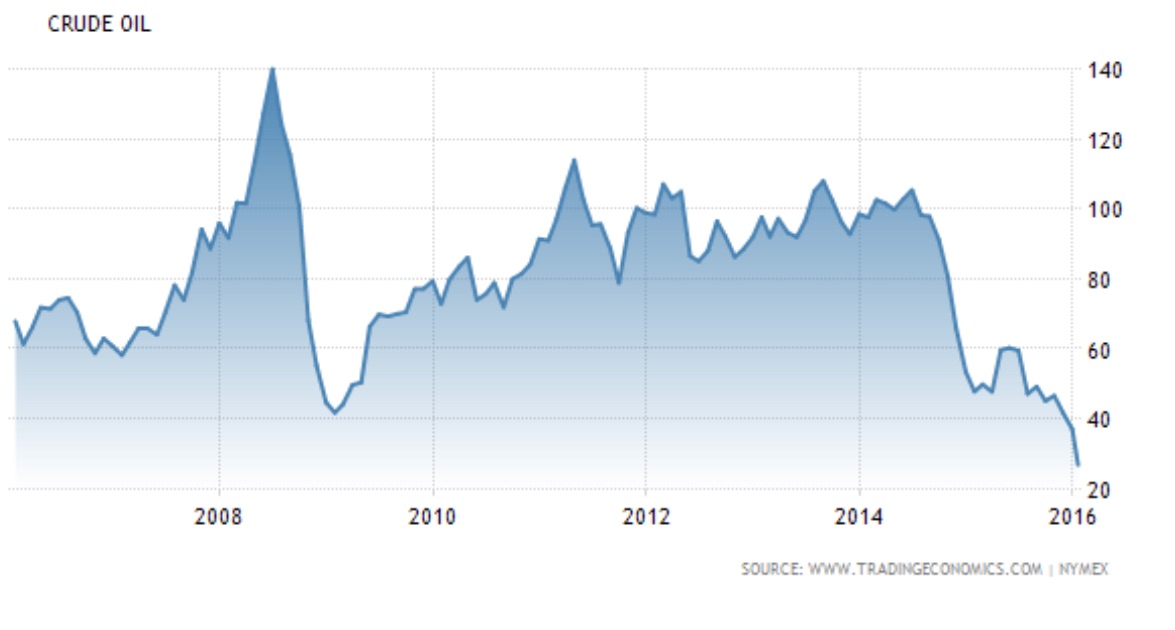
by Andrew | Aug 14, 2015 | Definitions, Federal Reserve, In the news

The PBOC stunned world markets this week with a series of consecutive devaluations of the Yuan, dropping nearly 5 percent against the US dollar and poised to weaken even further in the days and weeks ahead. The Yuan devaluation is just the latest in long list of policy responses to help stimulate China’s slowing economy, although this latest move is likely to have broad reaching implications for the rest of the world. Chinese monetary authorities increased the currency’s reference rate against the dollar by 1.9% without warning in the early hours of Tuesday morning, and have continued to intervene in the broader currency markets ever since. The biggest move in the CNY prior to Tuesday’s devaluation was a meager 0.15% as the currency remained tightly controlled by the authorities, emphasising just how shocking the 1.9% move on Tuesday has been for investors’ collective psyche. Chinese officials have been justifying the devaluation by pointing to the strength in the US dollar over the past year which has caused the Yuan to appreciate significantly against the Euro and British pound in particular. While the Chinese argument has some merits, many analysts are viewing the move as an escalation of the “beggar thy neighbor” currency wars which have been raging throughout the world since the onset of the financial crisis in 2008. The obvious question world markets are currently having to contend with now that China has officially entered the global currency war, what implications will this latest move have for broader markets including China’s immediate neighbors, the US dollar, and Federal Reserve policy going forward?
Emerging Markets Set to Follow China’s Lead
One of the biggest threats to emerge from the recent Yuan devaluation is a potential full blown currency crisis in emerging world FX rates. Prior to China’s devaluation, many of these countries were already struggling with weak currencies and mounting current account deficit issues. Collapsing commodity prices have placed a significant strain on these countries budgets, and now they face the unenviable task of having to devalue their currencies further in order to keep in step with China. The risk of contagion from this sort of mass currency intervention is clear. Many corporates in Asia and other emerging markets have been borrowing US dollars since the 2008 crisis due to the zero percent interest rates and widespread belief that their own domestic currencies would continue to appreciate against the dollar. This type of behavior should sound familiar, it is the exact same line of thinking which sparked the Asian financial crisis of the late 1990s. Faced with plunging domestic currencies, the cost of servicing US dollar debt is set to climb sharply for these corporates. Stephen Jen, a prominent analyst who called the Asian currency crisis in the 1990s while working for Morgan Stanley predicts emerging market currencies could fall a further 30 to 50 percent from current levels in response to the declining Yuan. The implications of such a move on these economies would be devastating – a toxic mixture of inflation and widespread corporate insolvency. Many of these nations have been a key driver of global growth in recent years, so weakness in their economies are likely to be felt on a worldwide scale
Faced with plunging domestic currencies, the cost of servicing US dollar debt is set to climb sharply for these corporates. Stephen Jen, a prominent analyst who called the Asian currency crisis in the 1990s while working for Morgan Stanley predicts emerging market currencies could fall a further 30 to 50 percent from current levels in response to the declining Yuan. The implications of such a move on these economies would be devastating – a toxic mixture of inflation and widespread corporate insolvency. Many of these nations have been a key driver of global growth in recent years, so weakness in their economies are likely to be felt on a worldwide scale
Where Does the Federal Reserve Go From Here?
Ongoing weakness in China and emerging markets at large are likely to be felt more acutely in developed economies in the months ahead. The biggest concern amongst many analysts is the potential for a return to the deflationary pressures which dogged sentiment in the US economy in the early part of 2015. These concerns are warranted. Commodity prices have continued to collapse in the past few weeks with the price of crude oil in particular hovering dangerously around the $40 per barrel mark, the lowest price in over 6 years. The low price of oil and energy related costs will have significant ramifications for both the CPI and PPI data in the months ahead, and it seems increasingly likely that a return to negative readings for CPI in particular is a real probability for the August and September data which should be released in the fourth quarter. Armed with the knowledge that these types of headwinds are in the post for the US economy, it seems increasingly unlikely that the Fed will lose its nerve to begin raising rates at its upcoming September meeting. The more cynical among us could even argue that China’s devaluation has been a dream come true for the Fed as it gives it enough cover to delay raising rates due to “external” factors and opens the door for more QE. And more QE at the end of the day is what every wants. The government wants it, the market wants it, emerging markets want it, and it looks increasingly likely that they will get it in the months ahead. The worrying element to all of this is that the current weakness across world markets is systemic – it feels far more dangerous than 2008 and we are now on the eve of a bigger crisis knowing full well that the world’s central banks have no credible policy response to deal with it.
by Andrew | Jul 31, 2015 | Definitions, Federal Reserve, gold, In the news

The Federal Reserve kept interest rates on hold at its latest policy meeting Wednesday, ensuring interest rates will remain near zero for at least another two months. Fed officials closed ranks voting 10-0 to keep interest rates unchanged, In what was a widely expected move by the broader market. With only three policy meetings remaining in which to make good on Janet Yellen’s signal to raise benchmark interest rates by the end of the year, the Fed faces an increasingly difficult decision on whether to move in September, or delay any change in policy to next year. Given the ongoing volatility in global markets, their decision will not be an easy one.
At the heart of the Fed’s dilemma is an improving employment picture, which goes some way to fulfilling the Fed’s mandate of achieving maximum employment, and has been cited on numerous occasions by Fed officials as the reason to start normalizing interest rate policy. Unemployment has fallen from nearly 10% at the height of the financial crisis in 2009, to 5.3% currently, and official month to month data continues to show signs of improvement. The advance reading of initial unemployment claims this week was 255,000, a drop of 26,000 from the previous week. The latest data marks the lowest level of weekly initial unemployment claims in over 41 years. Consensus expectations had been calling for initial claims numbers closer to 278,000. All else being equal, the employment figures would be enough for the Fed to start hiking rates at their September meeting, but everything else is not equal. There are several financial storms raging all across the globe which the Fed will need to ensure they do not exacerbate.
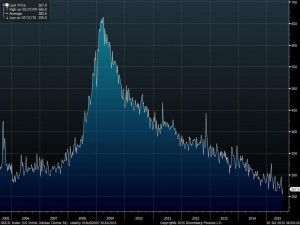
Commodity Price Rout Raises Deflation Concerns
The global rout in commodity markets is of particular concern, and plunging prices could see a return of the deflationary conditions which plagued the US CPI data for the first quarter of this year. Any increased probability of deflation would put
the other half of the Fed’s dual mandate of ensuring price stability in jeopardy, and any uncertainty regarding this half of the equation is likely to instill an increased degree of caution amongst Fed officials when it comes to raising rates.
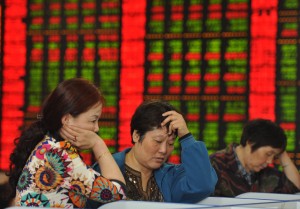
The potential impact of the recent commodity crash was outlined in a recent report by Deutsche Bank analysts, who found that the current -29% drop in the benchmark CRB commodities index is likely to severely impact headline inflation in the coming months. DB forecasts headline CPI inflation to fall from 01.% currently to -0.9% in the next few months. If they are correct, this would be the biggest year over year drop in inflation since September 2009, and one of the lowest inflation levels on record.
Timing of Fed Hike Continues to be Pushed Out
Market reaction to the Fed’s latest minutes was upbeat, with benchmark US equity indices all posting modest gains. Treasuries rallied with yields falling on the back of increasing signs that a growing segment of investors are starting to discount the probability of any rate rise this year. A broader recognition of this new environment is likely to cement itself in the coming days after wall street analysts continue to digest the ongoing rout in commodity markets, and downward GDP revisions begin to come through. If the Fed fails to hike in September it is very unlikely that it would test the resolve of global markets by hiking in the midst of peak holiday season in December, a period when world wide liquidity is wafer thin and trading desks staffed by fresh faced grads out of college. The reality looks increasingly, as we have been saying all year, that there will be no hike this year – the earliest and most likely timescale for any rike would be mid 2016 at best. By then there should be some clarity on any potential impact from the fallout in China, and if the deflationary trends which were so prevalent at the start of the year reappear. Should deflationary conditions return, there will be virtually no room for the Fed to progress with its normalisation policy – and given the heightened volatility across global markets, it seems increasingly likely that a return to increased QE is likely to occur long before any rise in rates.
by Andrew | Jul 17, 2015 | BLS, CPI, Definitions, In the news, Inflation, Monthly CPI Updates
U.S. consumer prices increased for the fifth consecutive month in June, led higher by a rebounding price of gasoline, although there was nothing in the latest release which should pose any immediate alarm for markets or consumers at large. The latest report from the BLS reported an overall increase in headline inflation of 0.3% month on month – an increase that was inline with nearly all economists polled prior to the announcement. Looking at the headline number on an annualized basis, inflation rose 0.1 percent In the 12 months through June, following an unchanged reading for the month of May.
Gasoline prices rose 3.4% month on month, following a 10.4 percent surge in May. Given the recent volatility in crude oil prices and inventory data in July, there could be scope for the influence of rising gas prices to subside in coming months. Oil is currently trading within the $50-60 / bbl range, well below the levels seen in May and June.
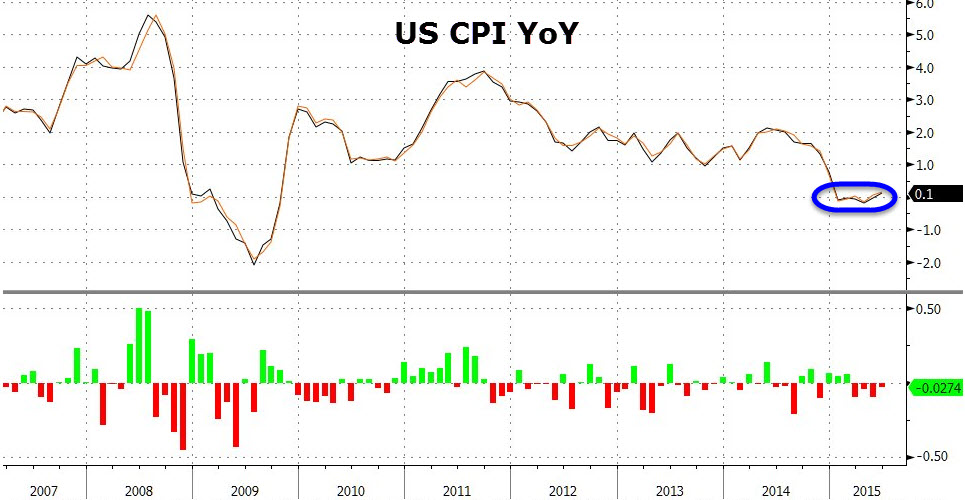
Core CPI, which excludes food and energy related costs, increased 0.2 percent month on month following a rise of 0.1% previously. On an annualized basis, core CPI has now risen 1.8 percent.The June reading continues to highlight just how tame the inflationary environment is within the US economy at present. The strong dollar is helping to keep a lid on inflation by reducing the price of imports and wholesale costs. The strong US dollar has been been spurred partly by a flight to safety due to concerns in Europe and China, and partly by the market’s anticipation of a Fed rate hike later this year. We should expect to start hearing comments regarding the damaging effects of the stronger dollar by Fed officials in the weeks and months ahead should this trend continue.
The food index posts largest increase since September 2014
The price of food increased 0.3% in June, largely to an ongoing shortage in wholesale eggs which has caused a sharp jump in retail egg prices across the nation. Egg prices jumped 18.3% in June, the largest monthly gain since August 1973. Elsewhere, the index for meats, poultry, fish, and eggs rose 1.4 percent in June, with the beef index rising 0.9 percent. Food prices are likely to remain elevated in the coming months as the aftermath of the bird flu epidemic works its way through the supply chain. Wholesale food costs have been consistently increasing in PPI surveys, and these costs are likely to make their way down to the consumer in the weeks and months ahead.
Medical Price Inflation starting to cool off
Medical related inflation cooled in June which will be a welcome deviation from the overall trend in 2015. The price for Medical Care Services fell -0.2% in June and the prices for Medical Care Commodities remained unchanged month on month. Health care costs have been one of the largest contributors to inflation over the past 12 months, with both indices rising 2.3 percent and 3.3 percent respectively.
Rent Prices continue to Climb Higher
The shelter index climbed 0.3% in June, and 3% on an annualized basis as the supply of housing continues to shrink in key regions. Rent increases are also amongst the largest contributors to overall inflation in the United States within the past 12 months.
Outlook for Rates
This month’s CPI data contains no surprises, and the relatively tame reading in the core number on the back of the strong US dollar will likely stick in the minds of Fed officials in the weeks ahead. Globally, sentiment continues to wane dramatically given the continued turmoil in Greece, and increasingly China. While Greece appears to be on the verge of some sort of political settlement, the headline risk remains. In China’s case, there is a very real danger of investor sentiment turning, which could spell disaster for emerging markets overall. Latin American and South East Asian markets look at particular risk, especially on the currency front. The fate of these regions would be sealed in no uncertain terms should the Fed raise rates, and it is for this reason that it appears increasingly unlikely that the Fed will raise by year end, despite all of their rhetoric and expressed intention to do so.














